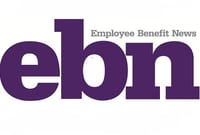Although the financial wellness of employees has emerged as a top priority for employers in recent years, too many workers are still struggling to improve their financial health.
According to the MassMutual Workplace Financial Wellness Study released earlier this month, eight out of 10 retirement plan sponsors believe their employees have financial difficulties, and 67% of sponsors are concerned about their workers’ financial readiness for retirement. The survey also revealed that 46% of plan sponsors which have concerns about their employees’ financial wellbeing are worried because they feel worker participation in their sponsored plans isn’t as high as they would like.
With the new year looming just around the corner, sponsors, like all businesses, are evaluating their performance over the past 12 months, and how they can improve in the year ahead. Making enhancements to financial wellness programs for employees on an ongoing basis is certainly a commendable initiative for sponsors to continue pursuing after New Year’s Day.
But for sponsors taking an active interest in promoting and improving employee financial wellness, the major challenge remains effectively quantifying the benefits of their programs. Just how much have your financial wellness efforts strengthened employees’ overall financial security, or increased their readiness for retirement?
Financial wellness can be complicated to quantify because employees have different financial goals and personal circumstances. Identifying the status of an employee’s overall financial wellbeing involves extensive engagement—obtaining a good understanding of their living situations, expenses, and spending habits in order to find out how much they need to save to achieve a financially secure retirement. This can be time-consuming, especially for larger organizations, and could also be considered intrusive by some participants.
A Quantifiable Financial Wellness Solution Requiring No Engagement
To help participants improve their financial wellness by increasing their retirement savings, sponsors can promote their plans as havens where employees can consolidate and grow their 401(k) savings. Auto portability—the routine, standardized, and automated movement of a retirement plan participant’s 401(k) savings from their former employer’s plan to an active account in their current employer’s plan—can significantly streamline the process of completing a roll-in transaction for employees as soon as they join a new employer.
The auto portability solution is powered by paired “locate” and “match” algorithms which are designed to track down and identify participants with more than one 401(k) savings account in the retirement system, and begin implementing a roll-in.
Crucially, auto portability’s algorithms undertake this process automatically (while giving participants the chance to opt out if they choose), without plan sponsors having to spend money on engaging participants.
Much has been written in this column about the lack of seamless plan-to-plan portability in today’s mobile workforce, and its impact on our country’s retirement system. The Employee Benefit Research Institute (EBRI) estimates that 14.8 million participants change jobs every year, and according to research from the largest plan record-keepers, nearly one-third (31%) of these participants will prematurely cash out their 401(k) savings balances within one year of going to another employer.
Prematurely cashing out one’s 401(k) account savings is one of the most destructive decisions that retirement-savers can make. According to our research, a 30-year-old who cashes out a 401(k) account with $5,000 today would forfeit up to $52,000 in earnings they would have received by age 65, if we assume the account would have grown by 7% per year. Furthermore, cash-out rates are higher among workers who are between ages 20 and 29 (44%, according to Fidelity), earn low salaries ranging from $20,000 to $30,000 per year (50%, per Fidelity), and are members of minority communities (63% for African-Americans and 57% for Latinos, according to Ariel Investments and Aon Hewitt).
Stranding 401(k) savings accounts in former-employer plans also isn’t a good strategy, but at least the savings remain invested in the U.S. retirement system. We have found that if the same hypothetical 30-year-old described above left $5,000 in 401(k) savings behind in their former-employer plan today, they would be stuck with $2,052 in fees on their account balance by age 65—and on a compounded basis, those fees would translate to $8,488 in total lost savings over that 35-year period.
Facilitating portability, whether through an automated program such as auto portability for small balances, or an assisted roll-in program for large balances, has proven to reduce destructive cash-out behavior. In 2013, Boston Research Technologies published a report stating that a large provider of healthcare services managed to successfully decrease cash-outs of all account balances in its plan by 50%.
Also, “The Mobile Workforce’s Missing Participant Problem,” a study conducted by Boston Research Technologies Founder and CEO Warren Cormier in collaboration with Retirement Clearinghouse (and published in March 2018), found that 60% of participants would prefer an automated process to consolidate their 401(k) accounts and update their addresses in current-employer plans.
EBRI predicts that up to $2 trillion, measured in today’s dollars, would be preserved in the U.S. retirement system if portability solutions that eliminated cash-out leakage were widely implemented. Sponsors can demonstrate their commitment to financial wellness by adopting a portability program in order to help new, current, and terminated employees improve their retirement outcomes.
But sponsors can also measure this dedication to financial wellness by demonstrating the increase in their plans’ average account balances since incorporating auto portability, as well as reductions in cash-outs.
At last, sponsors can actually measure the success of their financial wellness initiatives—and obtain peace of mind that their programs are indeed raising retirement prospects for their plan participants.

